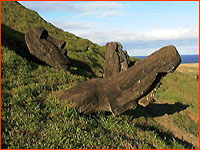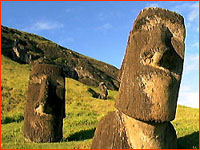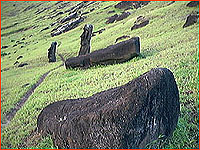
|
 |
 |
 Rano Raraku
Rano RarakuThe main quarry for Easter Island's statues, this volcanic crater is a virtual moai graveyard. The stone-faced giants lie in various states of production. Some are half carved, many are broken, and many seem to have been abandoned in mid-transport. Most remarkably, at the base of the quarry, moai stand half buried in the slope—up to their chins and noses—from years of erosion. To some observers the quarry looks like a graveyard of stone giants. It's as if the production of moai was abruptly abandoned, leaving us a frozen snapshot in time so we can look closely at exactly how the moai were carved out of the available rock. This quarry and the nearby transport road is the staging area on which many speculators base their theories on how the moai were transported. Archaeologist Jo Anne Van Tilburg suggests that the moai production in Rano Raraku quarry probably started and stopped often over the years, possibly due to periodic resource shortages or to political disagreements. 

QTVR (get QuickTime)
Object QTVR (get QuickTime)  Rano Raraku Moai QTVR 4
Rano Raraku Moai QTVR 4
Ahu Akivi | Ahu Tahai | Ahu Tongariki | Ahu Vinapu | Anakena Beach Orongo | Paro | Hanga Roa | Rano Raraku | Terevaka Photos: (1-5) Liesl Clark; (6-9) UCLA Institute of Archaeology Move a Megalith | Dispatches | Explore the Island | Lost Civilization Resources | E-mail | Table of Contents | Easter Island Home Editor's Picks | Previous Sites | Join Us/E-mail | TV/Web Schedule About NOVA | Teachers | Site Map | Shop | Jobs | Search | To print PBS Online | NOVA Online | WGBH © | Updated November 2000 |